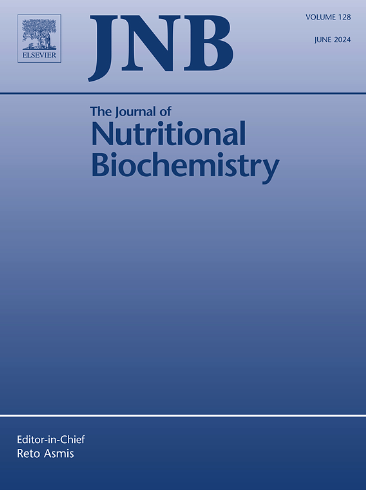Unsaturated fatty acids enhance mitochondrial function and PGC1-α expression in brown adipose tissue of obese mice on a low-carbohydrate diet
IF 4.8
2区 医学
Q1 BIOCHEMISTRY & MOLECULAR BIOLOGY
引用次数: 0
Abstract
Brown adipose tissue (BAT) exhibits greater resilience against inflammation compared to white adipose tissue. However, chronic consumption of a high-fat diet can render brown adipocytes vulnerable to proinflammatory conditions, leading to a decline in their thermogenic capacity and subsequent dysfunction. The analysis of the effects of type fatty acids intake must be important in the context of the dietary pattern and obesity. This study aims to investigate the impact of a low-carbohydrate/high-fat diet, enriched with different types of fatty acids, on mitochondrial activity on brown adipose tissue in obese mice. Male mice were allocated into different dietary groups: a control diet (CTL), and a high-fat diet (HFD) for a duration of 10 weeks to induce obesity. Subsequently, the HFD group was subdivided into the following categories for an additional 6 weeks: HFD with a low carbohydrate content enriched with saturated fatty acids; HFD with a low carbohydrate content enriched with fish oil; HFD with a low carbohydrate content enriched with soybean oil; and HFD with a low carbohydrate content enriched with olive oil. The findings indicated that in comparison to a low-carbohydrate diet rich in saturated fats, diets rich in unsaturated fatty acids—particularly omega-6 (n-6) and omega-9 (n-9)—resulted in elevated expression of UCP1, a marker of BAT activity. Moreover, there was an increase in the expression of PGC1-α, a protein involved in mitochondrial biogenesis, and enhanced functionality of the oxidative phosphorylation system within BAT mitochondria. These results suggest that n-6 and n-9 fatty acids may confer greater benefits to BAT functionality than saturated fats within the context of a low-carbohydrate diet. Therefore, this study revealed some molecular components that mediate BAT mitochondria function influenced by different fatty acids in a low carbohydrate diet, making it an important therapeutic target in obesity

求助全文
约1分钟内获得全文
求助全文
来源期刊

Journal of Nutritional Biochemistry
医学-生化与分子生物学
CiteScore
9.50
自引率
3.60%
发文量
237
审稿时长
68 days
期刊介绍:
Devoted to advancements in nutritional sciences, The Journal of Nutritional Biochemistry presents experimental nutrition research as it relates to: biochemistry, molecular biology, toxicology, or physiology.
Rigorous reviews by an international editorial board of distinguished scientists ensure publication of the most current and key research being conducted in nutrition at the cellular, animal and human level. In addition to its monthly features of critical reviews and research articles, The Journal of Nutritional Biochemistry also periodically publishes emerging issues, experimental methods, and other types of articles.
 求助内容:
求助内容: 应助结果提醒方式:
应助结果提醒方式:


